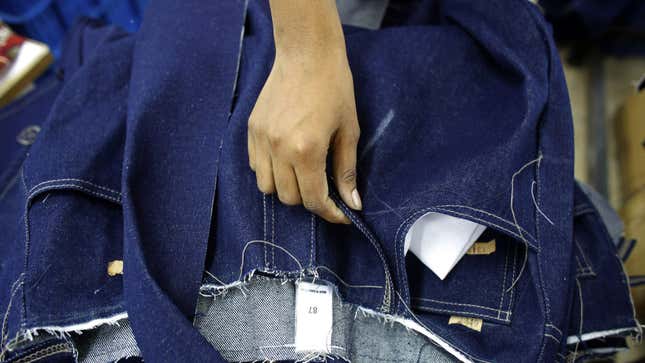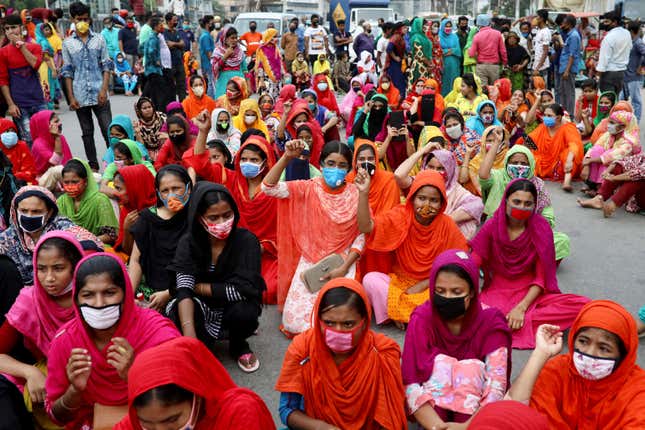Earlier this year, when Covid-19 shut down much of China, fashion supply chains slammed to a halt. It wasn’t just because China is the world’s largest clothing producer, accounting for about 32% of all clothing exported in 2018 based on World Trade Organization data—nearly five times the share of second-place Bangladesh.
Critically, China also produces most of the raw materials that factories in other countries depend on to stitch together finished garments.
The fabric, buttons, zippers, and leather patches on the jeans in your closet most likely originated in China, even if the tag indicates the jeans themselves were made—that is, cut and sewn—in a country such as Vietnam or Turkey. So when China implemented strict lockdown measures to control its outbreak of the new coronavirus, companies beyond its borders that were making jeans took a serious hit.
The problems didn’t end there. As Covid-19 reached end markets in Western Europe and the US, many non-essential businesses, including clothing retailers, closed their doors, while shoppers cut their spending on discretionary items such as clothes. Those two regions alone accounted for about 42% of the world’s $1.4 trillion in clothing and footwear sales in 2019, according to market research provider Euromonitor International. Suddenly, American and European shoppers weren’t buying fashion.
The situation is pummeling clothing companies. A recent joint report by McKinsey and fashion trade publication Business of Fashion estimated that global sales for the fashion industry, including apparel and footwear, will decline 27% to 30% in 2020 compared to the previous year.
The most significant suffering, however, is among the workers in the factories that make these clothes. Over the decades, fashion companies have concentrated their supply chains in countries with low wages in order to keep costs down and profits up. The garment workers who fill the factories often exist on the brink of poverty, without much of a safety net for themselves or their families.
Covid-19 is now sending shockwaves through that system, with devastating consequences for workers. The long-term outcome is hard to predict given the uncertainty around how the pandemic might be resolved. But factories in countries such as Bangladesh say what’s already happened has hurt months of future work. Many are unsure how or if they will survive. The more protracted the pandemic is, and more it stifles clothing sales, the greater the consequences are likely to be.

When the fashion supply chain went global
When Levi’s created the modern blue jean in San Francisco in 1873, patenting a design that used metal rivets to reinforce high-stress seams, the continent-hopping fashion supply chain of today didn’t exist. Back then, it was common for companies like Levi’s to operate as branded manufacturers: They didn’t just design and market their products, they owned the factories that produced them too.
It wasn’t the only way of working. Other clothing companies were already relying on contract manufacturers. In cities such as New York, the garment industry churned out large volumes of clothes, much of it coming from sweatshops employing poor immigrants at low wages.
Even then, outsourcing existed. Clothing production started spreading to cheaper regions such as Pennsylvania and southern US states.
But around the 1960s and 1970s, clothing factories started migrating to cheaper destination overseas in greater numbers. Travel and communication overseas were only getting easier, while places such as Hong Kong, Korea, Malaysia, and Taiwan, as well as Central America and the Caribbean, were ramping up their manufacturing. Clothing offered an easy entry point for building industry. Relative to other goods, it requires little specialized skill or equipment to make. In 1979, China began the process of economic reforms that would transform it from a country subsisting on farming to an export-oriented economy, and eventually the leader in clothing production.
As wages in those countries rose, clothing manufacturing found still cheaper options in Southeast Asian nations such as Bangladesh and Vietnam, as well as places like Turkey. Branded manufacturers were declining. In Asia, massive factories appeared to serve overseas clients such as Gap and Nike, which didn’t make their own products. They focused on design and marketing while seeking out the most cost-effective contractors to create their goods. Even Levi’s eventually outsourced nearly all its manufacturing to overseas contractors.

Under this paradigm Bangladesh has become a major player in the garment business, which in turn has become the focus of the country’s economy. In 1984, clothing made up less than 4% of the country’s total exports, according to data compiled by the BGMEA. A decade later, clothing was more than 60% of total exports. Currently, about 84% of Bangladesh’s exports are garments and the industry makes up about 11% of GDP.
Foreign brands have flocked to the country for their manufacturing because it’s incredibly cheap. The country has become the EU’s leading source of denim products such as jeans and one of the biggest sources of denim items to the US.
But because the clothing industry has been so hard hit by the pandemic, it also leaves Bangladesh especially vulnerable. “It’s a problem for garment workers everywhere, but for Bangladesh it’s particularly bad because the economy is so one-sided,” says Jette Steen Knudsen, a professor of policy and international business at The Fletcher School at Tufts University.

How jeans get made today
This is how the garment business in places like Bangladesh works. Companies place orders with a factory, and the factory sources and buys the fabric, trims, and other materials necessary to make the clothes. Often they pay for the items on credit. They rely on the payments they receive from fashion companies for the cash flow to pay the suppliers who sell them materials, their bank loans, and their workers.
Without these payments, everything comes to a standstill and workers don’t get paid. Last month in Dhaka, Bangladesh’s capital city, hundreds of garment workers protested for unpaid wages. “I did not get my wages for the last two months,” a 21-year-old woman told the Associated Press.

Factories have been forced to lay off or furlough large numbers of workers, many of them young women who rely on their wages for survival. One study estimated as many as a million garment workers were unemployed in Bangladesh. Garment workers in countries such as Cambodia and Myanmar are dealing with similar situations.
Mostafiz Uddin is the founder of Denim Expert Limited, a factory in Chittagong, Bangladesh. It typically makes jeans for international clients such as Spain’s Inditex, owner of fast-fashion giant Zara, and Arcadia Group, the UK company behind brands such as Topshop. Uddin says when industrial activity in China stopped due to Covid-19, the impact on his business was significant.
“The biggest effect came from accessories,” he says, as in buttons, zippers, and leather patches. “All these accessories come from China.” As his supply of these items dried up, he was unable to make finished garments, putting business on pause, and creating delays delivering goods to his customers. He also buys denim from China, though it’s actually not his main source, even though China is the world’s lead denim producer. He gets a small quantity from producers there when the end product is meant to be very inexpensive, but for most of the products he makes he sources fabric from mills in Pakistan, Turkey, and Italy.
But the delays from raw materials haven’t been his biggest problem. Many clothing companies have now suspended or canceled orders outright with manufacturers like Uddin.
Covid-19’s spread through Europe and the US forced retailers selling non-essential items, such as clothing, to close in unprecedented numbers. Shoppers have simultaneously pulled back on discretionary spending, leaving fashion companies unable to sell the inventory they currently have. To avoid accumulating more unsold goods, many have suspended or canceled orders they already placed. In April, a trade group representing Bangladesh’s garment industry, the Bangladesh Garment Manufacturers and Exports Association (BGMEA), said 1,134 factories reported canceled orders totaling more than $3 billion.
Denim Expert has had $10 million in orders canceled, Uddin says, equivalent to all its work for March, April, and May. He says he made a commitment not to lay off workers and hasn’t so far. But he doesn’t have the cash to keep paying them either.
Uddin has been vocal about the problems he and others like him face in Bangladesh, speaking to international press and writing opinion pieces for Bangladeshi outlets. Canceled orders aren’t the only difficulty he and others in the industry are navigating. Clothing companies have refused to take delivery of products already finished to delay having to pay for them, he says.
Typically, the purchase orders that brands place with garment factories will specify that, after receiving the finished clothes, the company has a period of 30, 60, or 90 days to pay. Now, even companies whose orders are already fulfilled simply aren’t taking possession of the goods, so manufacturers aren’t getting paid.
“I have cartons from Arcadia Group with $2.5 million in unshipped goods,” says Uddin, who has called for an overhaul of payment terms. “All the brands and retailers, they don’t want to take the goods, so there is no cash flow.”
Some companies have publicly committed to paying for placed orders, but many others have not. A number are asking if they can delay payment for several months, or demanding discounts of 30% or 50% on orders. Uddin says his margins are already slim. About 80% of payments from the companies goes to the cost of materials. The remaining 20% is what Denim Expert uses to pay its 2,000 employees and all its other costs, such as utilities.
The factory has been closed since the end of March, when the government shut factories in an effort to halt the spread of the new coronavirus. It has been allowing some to reopen, but Uddin isn’t sure whether Denim Expert will resume work this month. The future beyond is even less certain. Right now he has no orders for June or July.
Bangladesh has a program to help pay workers, but it only makes up about half their wages and has been slow rolling out. Reducing wages by that amount is enough for many workers to go hungry or be unable to pay their expenses. The program also doesn’t help factory owners like Uddin with their other costs.
Uddin’s worry is palpable. He is genuinely uncertain whether his business will survive. “We need help from our clients,” he says. “They are the only ones who can help.”
The scenario has underscored Bangladesh’s dependence on its garment industry, as well as how much that industry—and the international fashion companies that benefit from it—rely on low-cost labor. Knudsen says she has been traveling to Bangladesh for about five years, and in her conversations with government officials she has repeatedly heard them say they want Bangladesh to move up the “value chain” to manufacturing more complex products. But low costs are what attract all Bangladesh’s international clothing customers. There hasn’t been any need to invest in more automated production or advanced manufacturing. “The incentive hasn’t really been there because the workers are so cheap,” she says.
It’s unclear what the aftermath of the Covid-19 crisis holds. In Bangladesh, the calls to diversify exports from before the crisis may grow louder. Other economies that are highly dependent on garments, such as Cambodia, might see the same sort of response. Fashion companies, meanwhile, recognize their sourcing practices need to change.

How clothing supply chains could change
The Covid-19 crisis has forced brands and retailers to reexamine how they produce their goods. A lot of companies still work by placing large orders several months in advance. They don’t operate with the flexibility to adjust in a crisis and are now struggling as a result. A large number are also still dependent on China for most of their manufacturing.
Many companies were working to change these paradigms before the crisis, especially as costs kept rising in China and the trade war between China and the US escalated. But now those shifts are likely to accelerate.
In a May report, McKinsey looked at some of the ways fashion sourcing is set to change in response to the pandemic, surveying 116 sourcing executives at fashion companies and retailers, predominantly in North America and Western Europe, and talking to other industry stakeholders. Among its findings were that companies plan to shift more of their production from China to Southeast Asian countries that Covid-19 has disrupted less.
The shift could help rebalance the risks, costs, and flexibility of their supply in case of future disruptions, be they new outbreaks or new trade disputes between the US and China. Vietnam stands to be one of the bigger beneficiaries. Bangladesh, however, may actually see a decline.
Companies are also looking to increase the flexibility of their supply chains, in part to help manage the risk of major disruptions in their supply. One way they might do so is by moving some production to areas closer to their biggest markets. Companies that sell in the US might look to source goods in Mexico and Central America, while those that sell in Western Europe could consider Turkey, Morocco, and countries in Eastern Europe.
By producing closer to their customers and avoiding the long shipping times from Asia—what’s known as “nearshoring”—companies can produce smaller quantities of clothes on shorter lead times, making them less likely to get stuck with a mountain of inventory they can’t sell in a crisis. Though it can cost more to produce in those countries, it can still end up being more cost-effective overall. About 46% of the executives surveyed said they expect such nearshoring to increase in the next year.
There’s one problem with this option, though, and it goes back to the reason China’s coronavirus shutdown froze supply chains in the first place. Factories that assemble clothes in these countries still get many of their raw materials from China, especially synthetic fabrics such as polyester and specialized materials used for products such as activewear and outerwear. For a truly diversified and resilient fashion supply chain, these other countries need to develop their textile industries too.
Many of those McKinsey spoke to expect the crisis will drive this process, though it won’t happen overnight. Even as many clothing companies prepare to shift production out of China, a significant share also intend to maintain or even increase manufacturing there. That way they face fewer challenges in getting raw materials to manufacturers than if the materials need to cross national borders.
Other trends sourcing executives anticipate include more digital processes, and closer ties with their suppliers. They say they want to move away from transactional relationships to genuine partnerships, where they share strategic goals, and which could include companies co-investing with manufacturers to upgrade facilities and processes. Companies such as Nike, Adidas, and H&M have been moving in this direction, forging long-term ties with their best suppliers.
Many others, however, are still just looking for whoever will do the work fastest and cheapest. And companies of all kinds are likely to cut back on production as economic recessions in the US and Europe dampen spending on items like jeans. All indications are that millions of garment workers and people like Mostafiz Uddin will be left to fend for themselves.
“We should together solve the problem so that our poor workers should not suffer,” Uddin says, referring to the factory owners and international brands. “We both should consider how we can find a way to take care of these workers. I think this is very important, and this is not what happened this time.”
